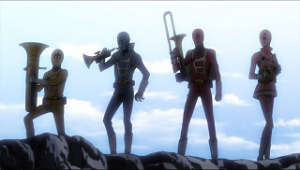 Kill la Kill #15 – Finally, a good old-fashioned all-out rumble between the forces of light and darkness! Or clothing and nudity, or whatever the heck these two sides turn out to be once Ryūko gets that explanation she’s been promised next episode. I wouldn’t rule out the big reveal ultimately putting her and Satsuki on the same side.
Kill la Kill #15 – Finally, a good old-fashioned all-out rumble between the forces of light and darkness! Or clothing and nudity, or whatever the heck these two sides turn out to be once Ryūko gets that explanation she’s been promised next episode. I wouldn’t rule out the big reveal ultimately putting her and Satsuki on the same side.
And finally, Satsuki and Ryūko have a chance to go after each other at full strength, no holds barred. There’s Kill la Kill doing what it does best– fast-paced action and over-the-top ludicrousness. I don’t have absolutely comprehensive knowledge of the giant robot subgenre, but I’m pretty sure those Nudist Beach machines are a strong contender for Most Ridiculous Mecha Ever.
And speaking of unlikely pairings… Mako and Gamagoori? Having seen what can happen when Mako puts her mind to something, the thought of the two of them working together somehow is terrifying.
Queen fans may well wonder if the title of “Don’t Stop Me Now” is a reference. The makers of the show have said that all the episode titles are the names of songs from the Showa era (1926-1989), but on the other hand, the Japanese edition of the Queen song just transliterated the title rather than translating it as far as I can tell from looking it up on the Internet. It’s possible this is named after some other song that happens to translate to the same title.
 Samurai Flamenco #14 – Yes, Japan does love its superheroes. And Mt. Fuji. (When the Worldcon was in Yokohama in 2007, the designer of that year’s Hugo trophy decided the obvious symbols to represent Japan were Ultraman and Mt. Fuji.) And when the latter is in danger, the former will appear, from… the land of fiction, whose boundary with reality is becoming increasingly permeable? More alien technology? Maybe just a bunch of Kaname’s actor friends? Except that Harakiri Sunshine appears to have actual powers.
Samurai Flamenco #14 – Yes, Japan does love its superheroes. And Mt. Fuji. (When the Worldcon was in Yokohama in 2007, the designer of that year’s Hugo trophy decided the obvious symbols to represent Japan were Ultraman and Mt. Fuji.) And when the latter is in danger, the former will appear, from… the land of fiction, whose boundary with reality is becoming increasingly permeable? More alien technology? Maybe just a bunch of Kaname’s actor friends? Except that Harakiri Sunshine appears to have actual powers.
Anyway, since it’s going through all the superhero tropes, I guess the evil twin was inevitable. (Or something like an evil twin, anyway; he addresses Masayoshi as “older brother”.) Next, single combat for the fate of Japan!
 Nobunagun #4 – One minute Shio is lamenting what a bunch of weirdos all the other E-Gene Holders are, and the next she’s enjoying the heck out of ricocheting around unprotected in a category 5 hurricane to kill aliens. Or maybe Nobunaga is. They are the same resurrected spirit within the mythology of the show, but two different people in their own way.
Nobunagun #4 – One minute Shio is lamenting what a bunch of weirdos all the other E-Gene Holders are, and the next she’s enjoying the heck out of ricocheting around unprotected in a category 5 hurricane to kill aliens. Or maybe Nobunaga is. They are the same resurrected spirit within the mythology of the show, but two different people in their own way.
The flashback is to shortly before the Battle of Okehazama, Nobunaga’s first notable victory. Having worked out where Yoshimoto Imagawa would be, he arranged an ambush that struck in the middle of a violent storm. The battle destroyed the Imagawa clan’s chance to be a contender for unifying Japan, and started Nobunaga on the road to doing so himself.
 The Pilot’s Love Song #4 – Oh, it would figure that the former prince would wind up falling for someone who’s secretly a hero of the revolution. The question is, why the need for a Claire/Nina to have a secret identity? Other than to drive the plot, I mean?
The Pilot’s Love Song #4 – Oh, it would figure that the former prince would wind up falling for someone who’s secretly a hero of the revolution. The question is, why the need for a Claire/Nina to have a secret identity? Other than to drive the plot, I mean?
This sheds some new light on exactly who’s in charge on Isla. Luís de Alarcón is not only the (alleged) discoverer of the Holy Spring, we’ve also seen that he has some kind of guardianship over Claire. This makes him the representative of the Amerianos, or else the person who to whom the Amerianos are beholden for providing the means to make the Wind Revolution happen.
Next episode we get a look back at Claire’s childhood. Is her control of the winds the result of natural abilities or technology? Why didn’t she mention her father when talking about her family?
On the Big Dumb Object front, nothing new here other than they seem to have some nebulae in the immediate vicinity. It’s just to emphasize that they are not in our solar system– I think…
 Hozuki no Reitetsu #15 – The hakutaku (or baí zé in Mandarin) is a legendary creature associated with warding off disease and bad luck. Its most famous moment in mythology is its appearance to the emperor Huang Di to dictate a list of 11,520 monsters and spirits, and here we see that it has a longstanding quarrel with Hōzuki sparked by a failure to contemplate the limits of the gender binary. Kids, educate yourself so you don’t wind up making the same mistake!
Hozuki no Reitetsu #15 – The hakutaku (or baí zé in Mandarin) is a legendary creature associated with warding off disease and bad luck. Its most famous moment in mythology is its appearance to the emperor Huang Di to dictate a list of 11,520 monsters and spirits, and here we see that it has a longstanding quarrel with Hōzuki sparked by a failure to contemplate the limits of the gender binary. Kids, educate yourself so you don’t wind up making the same mistake!
Here we get the quick information dump about Hōzuki’s name. In English, Physalis alkekengi is most popularly known as the Chinese lantern plant for the bright red-orange husks it grows around its fruit. The design on the back of Hōzuki’s robe is a stylized image of one of those husks.










